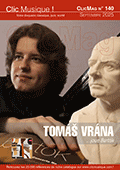 Comme nombre de compositeurs italiens d''opéra du dix-neuvième siècle (Puccini, Verdi...etc), Amilcare Ponchielli l'illustre auteur de la Gioconda, fit ses premières armes de mélodiste et d'improvisateur à la tribune de l'orgue de sa ville natale Crémone, tout en apprenant le solfège au conservatoire de Milan. Les œuvres compilées par Paolo Bottini publiées entre 1855 et 1860 sont donc des opus de jeunesse, exercices de style empruntés au vocabulaire commun de l'organiste et souvent inspirées par l'opéra et le bel canto comme le voulait la tradition. Elles sont en outre écrites pour être jouées aussi bien sur un piano, sur un orgue portatif que sur le grand orgue et destinées à un usage liturgique ou domestique. Tout en s'adaptant à ces contraintes stylistiques et lorsqu'il s'essaie à développer, le jeune Ponchielli manifeste çà et là quelques idées mélodiques et formelles (Sinfonia, Allegro Campestre, Tre Pezzi) usant même du contrepoint (Fugue) mais l'ensemble reste factuel. L'orgue Pacifico Inzoli quant à lui a été inauguré en 1873 par le compositeur lui-même et son confrère Vincenzo Petrali. C'est un instrument de très belle facture bien représentatif du facteur crémonais aux sonorités élégiaques et symphoniques typiques de ce répertoire. (Jérôme Angouillant)  Amilcare Ponchielli is part of the large group of composers today known almost exclusively for a single piece, in this case the Dance of the Hours taken from the opera La Gioconda, a fact that does not do full justice to a prolific and inventive author, who in the second half of the nineteenth century enjoyed considerable public and critical acclaim. Few people know that in March 1855 the not yet twenty-one-years-old composer obtained the position of organist at the Church of Sant’Imerio in Cremona, a position he held until 1860. During this five-year period he exploited all the technical and expressive resources of the organ built shortly before by Angelo Bossi, an instrument not very large, but perfectly in line with the aesthetic dictates of the time, which provided a very rich palette of sounds, with all the instruments of the symphonic orchestras – evidently the advent of the Cecilian movement was still to come. On this organ Ponchielli gave free rein to his imagination, composing a series of works with an evident operatic spirit, which are performed with extrovert brilliance by an inspired Paolo Bottini on the symphonic organ built by Pacifico Inzoli in 1873 for the Church of San Dalmazio Bishop of Paderno Ponchielli, the composer’s home town, a stylistic choice that could not be more authentic!
 |
